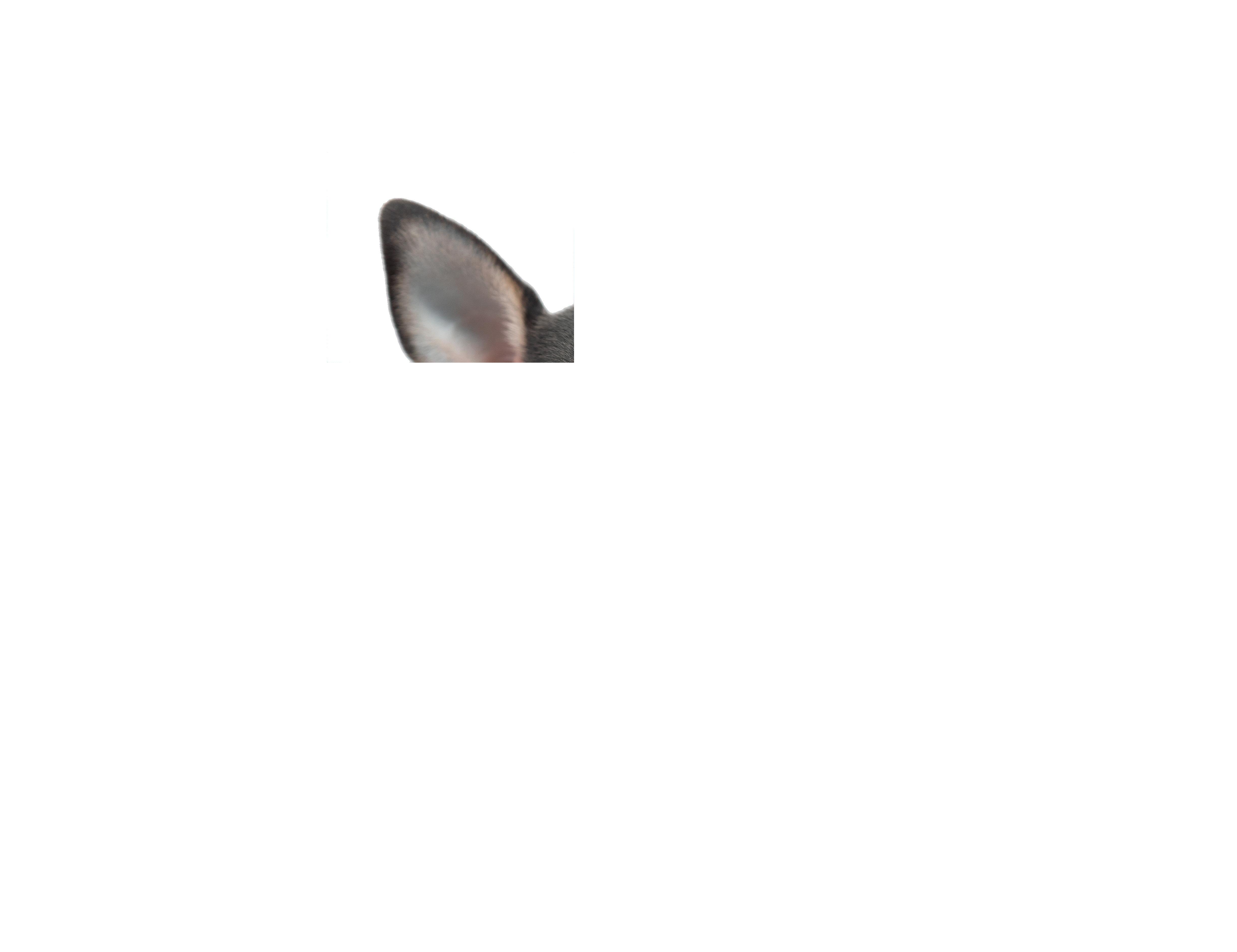
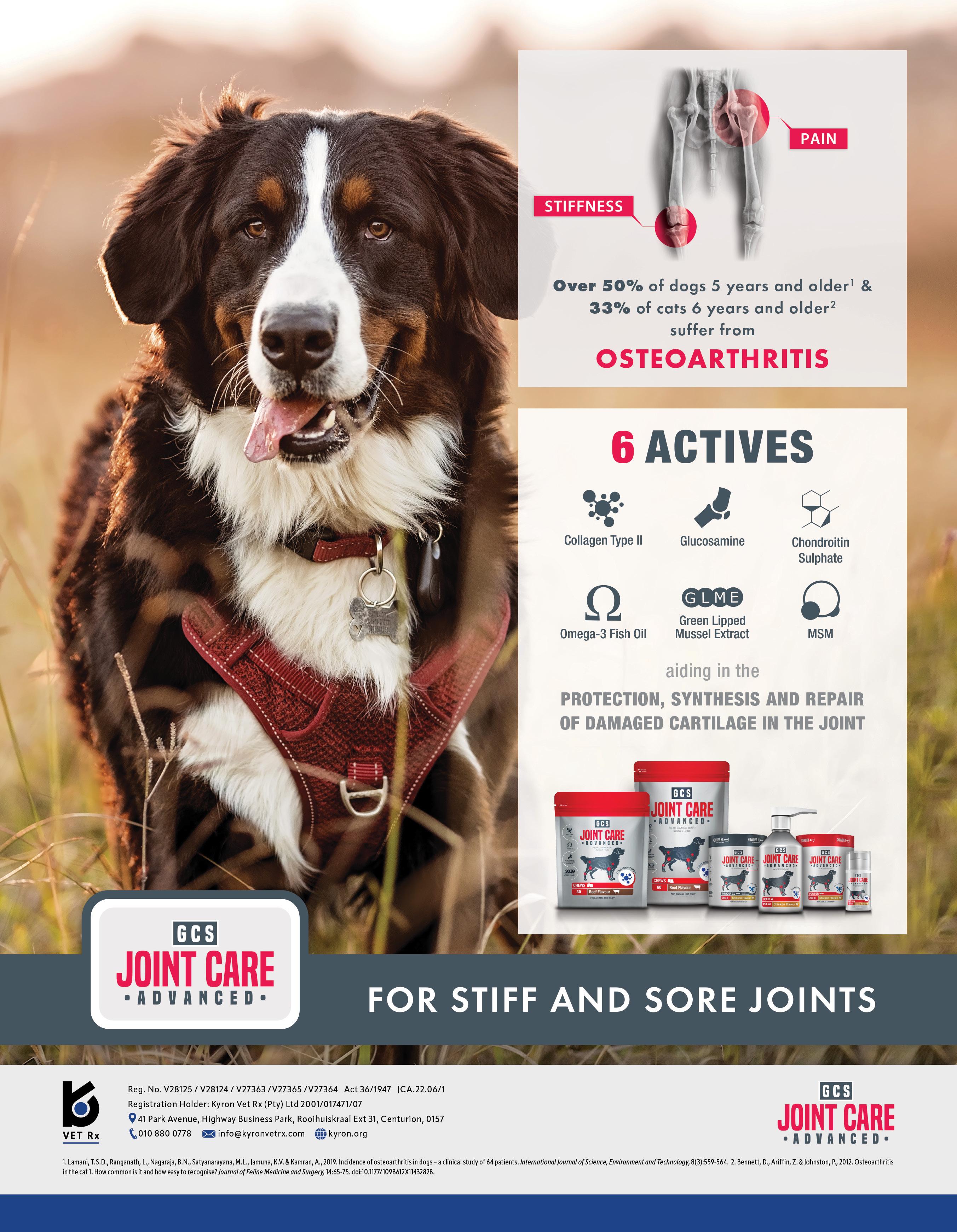
Hello!
Welcome to another edition of your favourite doggy magazine.
This is our eighth issue, and we’re delighted to have so much great content to share with you. From looking at managing thunderstorm fears to choosing a dog breed to suit your needs, there is something for everyone, from the most seasoned owners to the brand-new ones.
We’re constantly expanding our writer pool and wish to thank all who contributed to making this edition another great one. We must also thank our advertisers, who, through their support, allow us to make this magazine free for all who wish to read it. We couldn’t do this every month if it weren’t for them!
As always, if you have any suggestions for content or would like to submit an article for consideration, please get in touch with lizzie@dqmagazine.co.za. We love to hear from you!
For now, dive into this edition, and we’ll see you back on November 15th for another edition of DQ Magazine!
Much love,
Lizzie and the DQ team
DQ | 3B 3
Dr Lizzie Harrison | Editor
xxx Designer: Anne Royden-Turner
IN
The Chihuahua
DQ | 3B4
THIS ISSUE DIGITAL ISSUE 3B | 2022 06
Last month - the tallest dog in the world, this month - the smallest 14 Your dogs Meet Sarah, Matt, Shelby and Bentley 18 Getting a puppy for Christmas All the dos and don’ts for festive puppy shopping 22 Thunderstorm phobia How to handle the panic that comes with the rainy season 28 Foot in mouth The paw-licking problem 30 Making the best choices for our best friends Feeding fresh for our hound’s health and happiness 36 The Southern Africa Animal Cancer Association Creating awareness about cancer 40 The stages of puppy development 48 Heatwave health Beat the heat with these scorching safety tips 52 Canine enrichment Part 5 54 Basic exercises for your dog Part 3 58 Ask DQ Your dog questions answered 62 Products we love
Hilde is a shiny, happy and healthy dog!
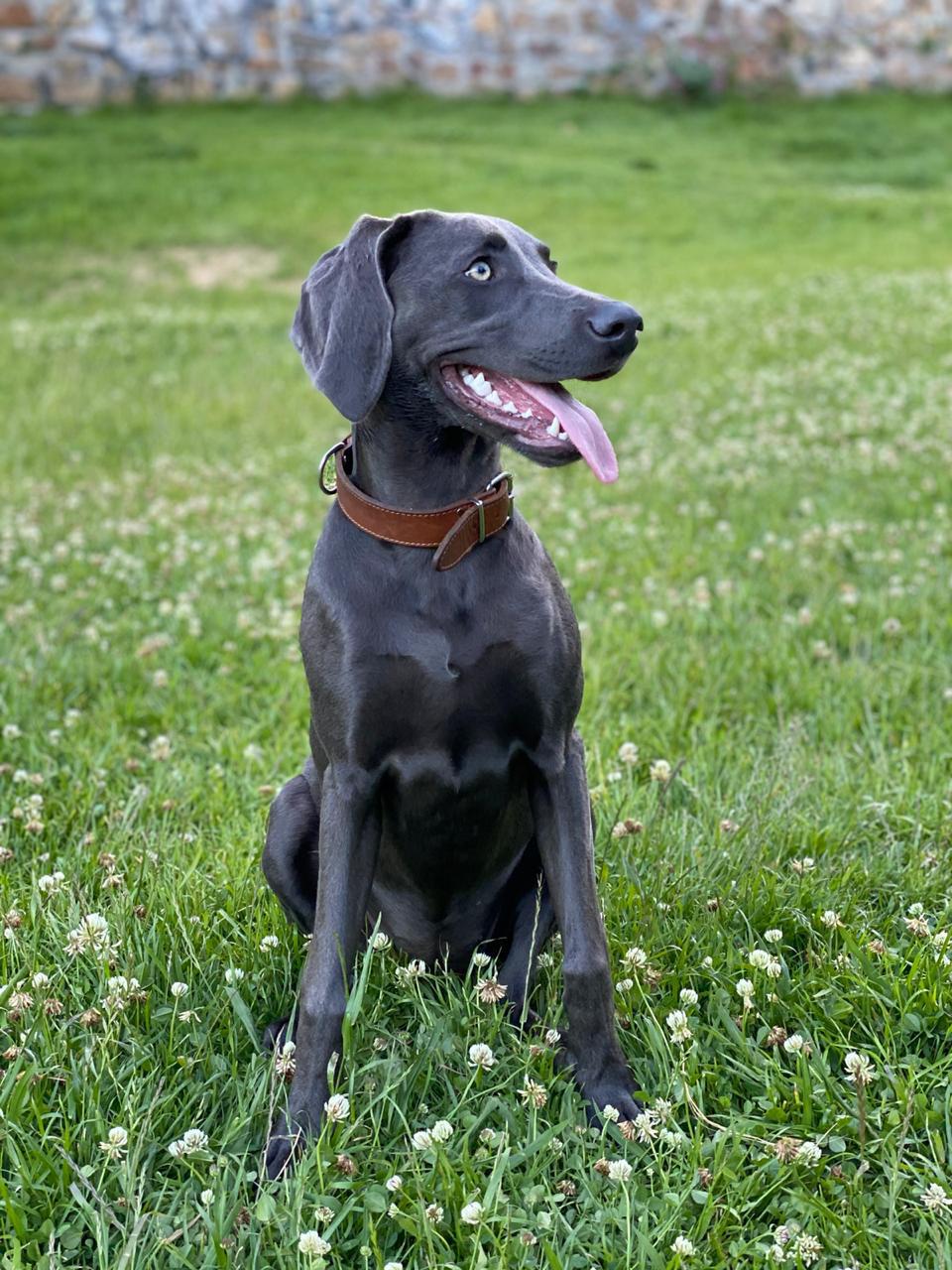
She has only ever eaten Happy Hounds, which has improved her gut health and immune system, and made her a HAPPY hound at meal times.
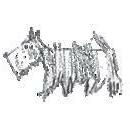
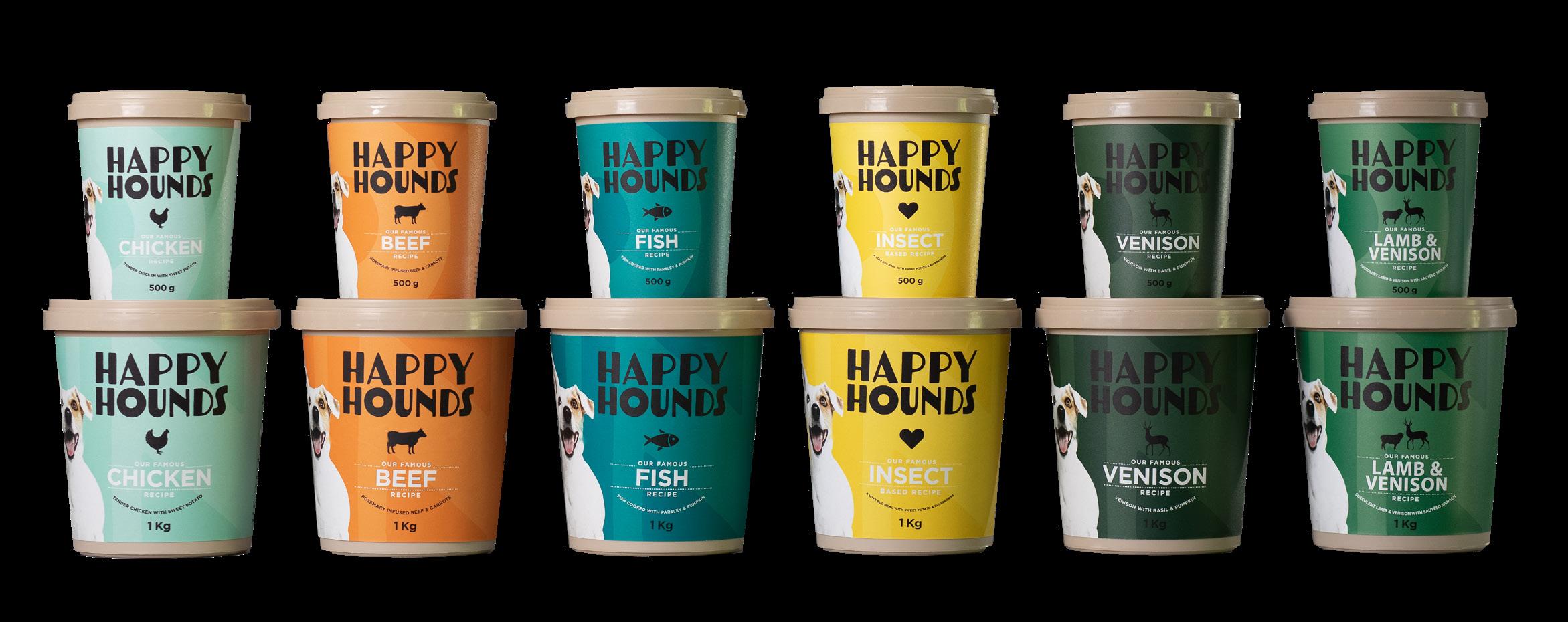






www.happyhounds.co.za • 064 874 5244 • sam@happyhounds.co.za

DQ | 3B6 BREED PROFILE
The Chihuahua
LAST MONTH - THE TALLEST DOG IN THE WORLD, THIS MONTH - THE SMALLEST

DQ | 3B 7
BREED PROFILE
Weighing between 900 grams and three kilograms, Chihuahuas are officially the smallest breed of dog in the world. Yet whilst their dimensions are small, they more than makeup for their size with their bravery and huge personalities. In short, they have no idea how tiny they are and, in no time at all, can be the 'largest' member of the household.
THE HISTORY OF THE CHIHUAHUA
The history and origins of the spunky little breed are a topic of some debate, but most agree the breed is one of the oldest in the world. A larger form of the Chihuahua, known as the Techichi, dates back to ancient Aztec and Maya
civilisations. Techichi were the guardians of the afterlife and were highly revered by their people. These dogs were mummified alongside their owners as early as 300BC in the hopes that they would join them in the next world. Explorers from all over the world entered these vast South American lands and took a shine to the Techichi. Pretty soon, these dogs were travelling back to the explorers' homelands and could be found across the globe. DNA testing of the breed by the American Kennel Club confirms that the Chihuahua's most likely point of origin is in South America, as the hypothesised Techichi origins suggest. There are records of tiny, pointy-eared dogs (much smaller than the Techichi but sharing many physical

BREED PROFILE DQ | 3B8
features) in Chihuahua, Mexico, in the early 1800s, suggesting these were some of the first true Chihuahuas as we know them today. Soon, these dogs were being sold across the border to American tourists. Though the breed didn't have an official name at this point, they quickly became popular. At this stage, they were named after the area where they were found, often called the Arizona Dog, Texas Dog, Mexico Dog, and of course, the Chihuahua Dog.
In the 1890s, opera singer Adelina Patti made the breed a household name as she toured with her canine companion, Bonito. Yet, the breed was only formally registered with the American Kennel Club in 1904. This versatile breed has been growing in popularity ever since.
A CHIHUAHUA OVERVIEW
Chihuahuas are toy breeds, small in size, and bred for companionship. They rarely weigh more than three kilograms but definitely make up for their small stature with a big dog personality. Chihuahuas come in both apple and deer head varieties and can have either long or short coats. Interestingly, like human babies, chihuahua puppies' skulls do not entirely close before birth. There is an open gap in their skulls called a fontanelle or moleras, which only closes as they get older. In some cases, the moleras don't ever close completely, even in adult Chihuahuas, though these dogs can live relatively normal lives regardless.
Despite their size, Chihuahuas are ranked as one of the


BREED PROFILE
DQ | 3B 9
BREED PROFILE
best watchdog breeds on the planet. They're extremely intelligent and alert and will be sure to sound the alarm at the slightest hint of an intruder. Their pricked ears, domeshaped head, and expressive eyes make them seem coy and harmless, but Chihuahuas are actually quite dominant personalities who require training to truly embrace their home lives. On the plus side, once you start training, you'll find Chihuahuas to be fast learners. They love to please and pick up basic commands very quickly.
LIVING WITH A CHIHUAHUA
Having a Chihuahua in your home can be likened to having a tiny Napoleon running around unless you instil boundaries at an early age. Though their diminutive stature makes them ideal for city living, Chihuahuas are active and intelligent dogs and will require a moderate amount of exercise. They're easily bored and enjoy advanced training and dog sports to keep their minds occupied.


DQ | 3A10
DQ | 3B

BREED PROFILE DQ | 3B 11
Chihuahuas are comical, loyal, and personable but generally bond to one or two people and prefer to stay close to their chosen family. They can be affectionate but also have an independent streak and prefer to accept and give affection on their own terms.

They are truly tiny dogs, meaning they aren't necessarily suited to homes with small children, as they need to be handled with care. They're also susceptible to the cold and need to be monitored in the winter months to keep the trembling to a minimum.
The breed is generally vocal and likely to bark at the slightest provocation, but this works out well if you're looking for a watchdog. Chihuahuas can be snappy with strangers and children under ten if they feel threatened or unsure; this is a built-in defence mechanism to combat the fact that they're minuscule. Socialisation is a must for these little guys to prevent unnecessary snappiness later on.
CHIHUAHUA HEALTH
Chihuahuas are hardier than they look and have aboveaverage life spans, but like with all breeds, there are potential health risks to be aware of when you have a Chihuahua. Their tiny mouths can lead to dental issues and plaque build-up, making regular dental check-ups necessary. Loose knee joints, also known as luxating patellas, are common in toy breeds, so limit jumping off high surfaces as much as possible, especially during their formative years. Collapsing trachea due to their tiny necks can be an issue, so these little pocket rockets are better off in harnesses than collars when on lead. Regular heart check-ups with the vet are also advisable.
DQ | 3A BREED PROFILE
IS A CHIHUAHUA THE RIGHT DOG FOR YOU?
A Chihuahua could be the right dog for you if:

• You're looking for a dog with a LOT of personality.
• You prefer small breed dogs.
• You're looking for a loyal and charming companion.
• You have the time and dedication to socialise your dog with strangers.
• You don't mind a bit of barking.
• You can handle a dominant personality in a tiny package.
• You're looking for a dog who's easy to carry, but be careful here! Chihuahuas need to learn they have legs and can fend for themselves.
• You need a dog who is easy to train.
• You want a dog to travel around with you.
• You're looking for a long-time companion.
• You want an alert watchdog in your home.
A CHIHUAHUA IS NOT THE RIGHT DOG FOR YOU IF:

• You have small children.
• You want a robust dog to play rough with.
• You don't have the time or the desire to monitor and supervise a fragile dog.
• You don't have time for house training - these little guys can be very tough to house train.
• Yapping annoys you.
• You don't want to socialise and train your dog.
• You live in an area where your neighbours are likely to complain about the noise.
• You're away from home a lot and need a dog who can be left to his own devices.
FINAL THOUGHTS
Chihuahuas are literal bundles of joy. They're quirky, playful, and fun to be around; having one in your home means you have no choice but to smile. Though their dominant personality and particular brand of loudness aren't for everyone, they truly are like tiny lions, courageous and indomitable. In many ways, these bite-sized little nuggets are the perfect companions.
DQ | 3B 13 BREED PROFILE
Meet Sarah, Matt, Shelby and Bentley
DQ: What are your dogs’ names?
Sarah and Matt: Shelby (our Lab mix) and Bentley (our Border Collie) - named after the cars - @pandapuppers
DQ: How old are your dogs, and how long have you had them?
Sarah and Matt: Both dogs are two years and nine months old. They are both lockdown dogs and were our absolute saviours during such a hard period. We got Shelby at nine weeks and Bentley at 12 weeks.
DQ: Do they have more brothers or sisters?
Besides each other, they have a much bigger equine sister, Twiggy.
DQ | 3B14
YOUR DOGS

DQ | 3B 15 YOUR DOGS




DQ | 3B16
DQ : What are their favourite treats?
Sarah and Matt: Both dogs will do just about anything for chicken (especially Woolworths Rotisserie chicken).
DQ : Do they have any hobbies or activities they take part in?
Sarah and Matt: We take Bentley sheepherding, and it is the most amazing experience watching that instinct kick in and being able to work with him. Shelby is a budding agility star (work in progress). Both dogs also love swimming, hiking and getting filthy.

DQ : What makes them unique?
Sarah and Matt: Bentley is just the most enthusiastic dog you will ever meet; his optimism is amazing despite all he’s been through. He’s such a loveable goofball.
Shelby is a little snuggle bug and is the reason we got through lockdown with mental health intact. Both dogs have been the inspiration I (Sarah) needed to take the next step and study towards working with dogs.
DQ : Why should your dog be DQ famous?
Sarah and Matt: In addition to being the bestest, fluffiest, smartest and most beautiful dogs out there ( ), I (Sarah) am still finding our voice on social media, but they have so much to teach people; Bentley about living with Progressive Retinal Atrophy (PRA), and both can teach about living and working with high drive, reactive dogs. It is so needed that people don’t always just get to see what we want them to see, and instead see the everyday life of dog owners with everyday struggles.
DQ | 3B 17 YOUR DOGS
GETTING A
PUPPY FOR CHRISTMAS

DQ | 3B18 DOGS AT HOME
ALL THE DOS AND DON’TS FOR FESTIVE PUPPY SHOPPING
The end of the year rolls around again, and suddenly everywhere you look, there’s another cute holiday movie full of puppies. It starts to get you thinking about how wonderful it would be to welcome a new canine companion into the family. As appealing as it sounds in your head, we all know getting a new dog is a huge responsibility. How do you know you’re ready for another dog? And if you are, what kind of dog is best suited to your lifestyle? Never fear, DQ is here to answer all your questions.
ARE YOU SURE YOU WANT A PUPPY?
The saying, “A dog is for life, not just for Christmas,” is never more true than over the festive season. Having a puppy in the house might be cute over the holidays when you’re at home, but everything changes when the new year kicks off, and you’re back in your routine. Think about whether you’ll still have time for a puppy, then. A dog is a lifetime commitment - not your lifetime, but theirs. If your situation is unstable at the moment, or you’re considering emigrating or downscaling in the new year, a dog may not be the best option for you at the moment. Not that we want to discourage you, but be just sure you’re ready for an adult dog as well as a puppy.
WHICH PUPPY IS BEST FOR YOU?
Okay, so you do want a puppy. You’re in the right place in your life to welcome the pitter-patter of tiny claws across your floors. So, what now? Do you have a specific breed in mind? Have you considered a rescue dog? Does your new dog even have to be a puppy? Before you can get any real clarity on what breed or age of dog you’re looking for, think about what you would like to get out of having a dog in your home. If you already have a dog, think about why you’re looking to grow your canine family. Here are some possible reasons you may have for wanting a puppy:
• You’re looking for a playmate for your other dog/s
• You want your child to have a puppy
• You’re looking for a companion for yourself to run with, wrestle with or cuddle at night.
• You’d like a pet and an extra level of security in your home
Whatever your reasons are, Google is your friend. Research which breed of dog meets your criteria, and do so with an open mind. You may have your heart set on a Yorkie for your child, only to realise he or she is too young to interact safely with such a tiny breed of dog, for example. Ethical breeders will be upfront with you about
DQ | 3B 19 DOGS AT HOME
whether or not their breed is suitable for you and will welcome any questions you might have, so feel free to reach out to them as well. In the meantime, we can give you a broad overview of breeds that may work for you.

A FAMILY DOG?
If you’re looking for a dog to lie at your feet in the evening while you watch Netflix and play with your kids in the afternoon, you have lots of options. Depending on the age of your children, there are some very robust and affectionate dog breeds out there that meet your criteria, including Labradors, Golden Retrievers, Irish Setters, and Beagles. If you have younger children, breeds like Pugs or Cavalier King Charles Spaniels may be an option. To narrow down the list, think about how much space you have and how much time you have to devote to grooming and exercising your new dog.
A ROBUST COMPANION?
Perhaps you lead a single life, or you have no children. If so, your needs will be different. Instead of a staple in the home, you may be looking for a more portable companion who can stand up to the rigours of running with you and a good old-fashioned wrestling match at night. Rhodesian Ridgebacks, German Shorthaired Pointers, Staffies, and Bull Terriers, could be excellent options for you. Just remember, some breeds of dogs prefer to be the only dog in the house, so pay attention to this if you already have a dog.
A LAP DOG?
If you’re looking for a small, affectionate snuggle bunny, then Toy and small breeds could be for you. Be warned, however, just because a dog is tiny doesn’t mean he is biddable. Chihuahuas, for example, have serious big dog
DQ | 3B20
DOGS AT HOME
attitudes and are just as likely to give you the runaround as a larger breed. Affectionate lap dog breeds include Yorkshire Terriers, Chihuahuas, Pugs, Pappilions, Maltese Terriers, and Italian Greyhounds.

A SECURITY GUARD?
Having a dog just for security purposes isn’t advisable. Dogs are pack animals, and they protect you better when they’re part of your family. Still, if you’re looking for a dog that packs a bit of extra punch on the home security front, German Shepherds (who are also excellent with children), Boerboels, Rottweilers, and Doberman Pinschers could be an option for you. Remember, all dog breeds need proper training and socialisation regardless of their purpose and temperament.
A WORKING DOG?
What if you want a dog to pour your time into? You want to do agility, advanced obedience, man work, flyball, and the works. Working dogs have high stamina and are extremely intelligent, and as a result, they generally don’t cope well with households in which they don’t have a purpose. An under-stimulated working dog is a nightmare, so be sure your desire to have one isn’t just a fad. If you’re serious about a working dog, Belgian Malinois, Border Collies, Australian Cattle Dogs, or Australian Shepherds could be an excellent choice for you.
DQ ’S PICK
There are so many dog breeds out there, and each one of them has a place in a home somewhere. For us this festive season, there’s only one breed of dog to consider: The Rescue Dog. More dogs end up at shelters in the comedown from the festive season than at any other time of year. The novelty of having a puppy wears off when he has chewed all your fancy new gifts. Adopting a dog from a shelter could change things and would be the best holiday present for the dog.
Consider a rescue dog - it’s never too late to find them a happy home, and what better time than the holidays to change a life?

DQ | 3B 21
DOGS AT HOME
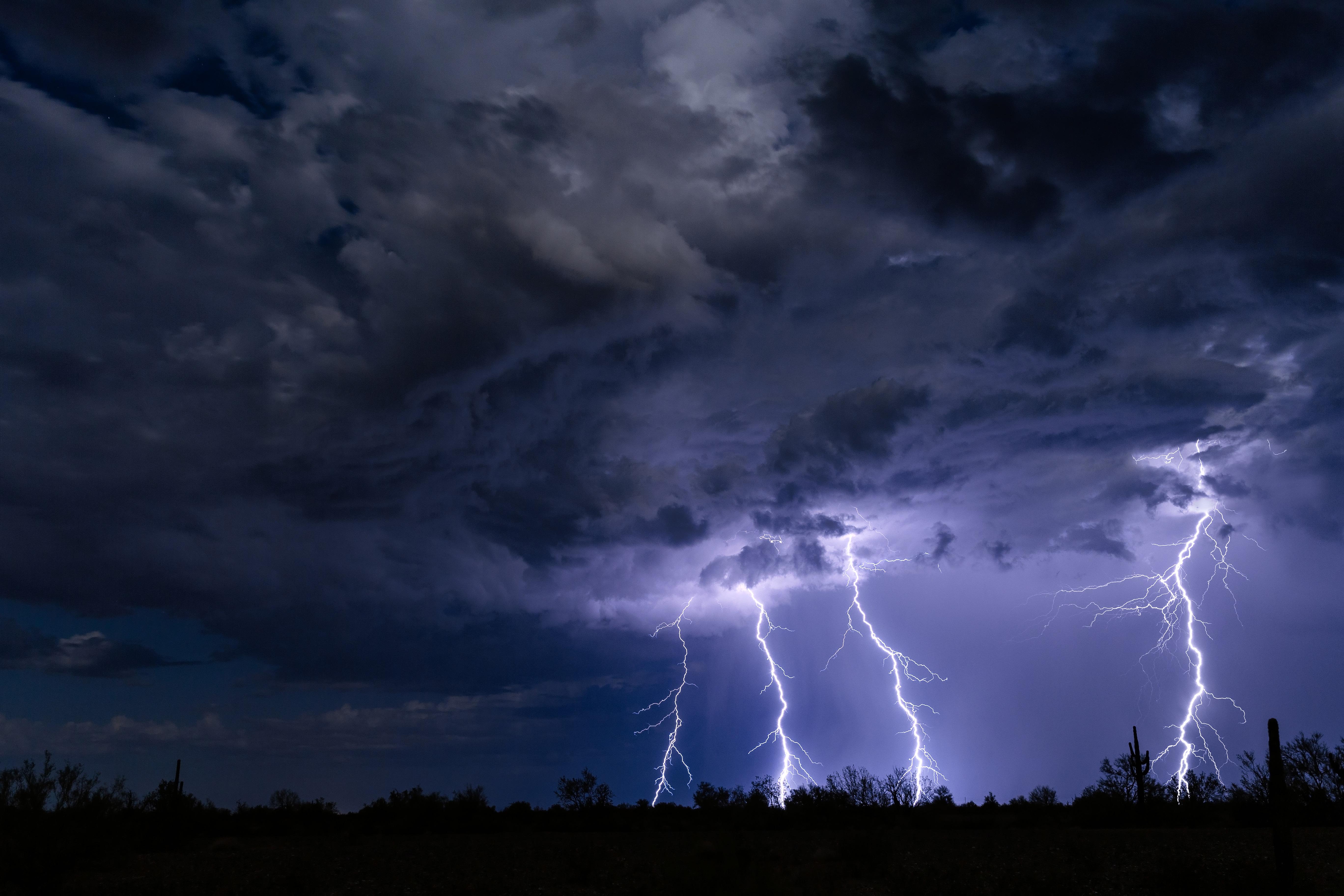
HOW TO HANDLE THE PANIC THAT COMES WITH THE RAINY SEASON THUNDERSTORM PHOBIA DQ | 3B22 DOG BEHAVIOUR TEXT: RHIANNON CECIL
DID YOU KNOW?
About 10% of lightning strikes occur when there is no rainfall.

DQ | 3B 23 DOG BEHAVIOUR
With the summer months come not only thunderstorms but also the festive season. For some dogs, this is akin to Armageddon, and their terror tends to put a damper on proceedings for the whole family. Every time the sky clouds over, panic mode sets in for dogs and humans alike, and we won’t even mention the new year’s fireworks. If your dog is one of those panicky pooches, what can you do to make the next few months bearable for everyone (especially your dog!)?
WHY ARE SOME DOGS AFRAID OF THUNDER AND FIREWORKS?
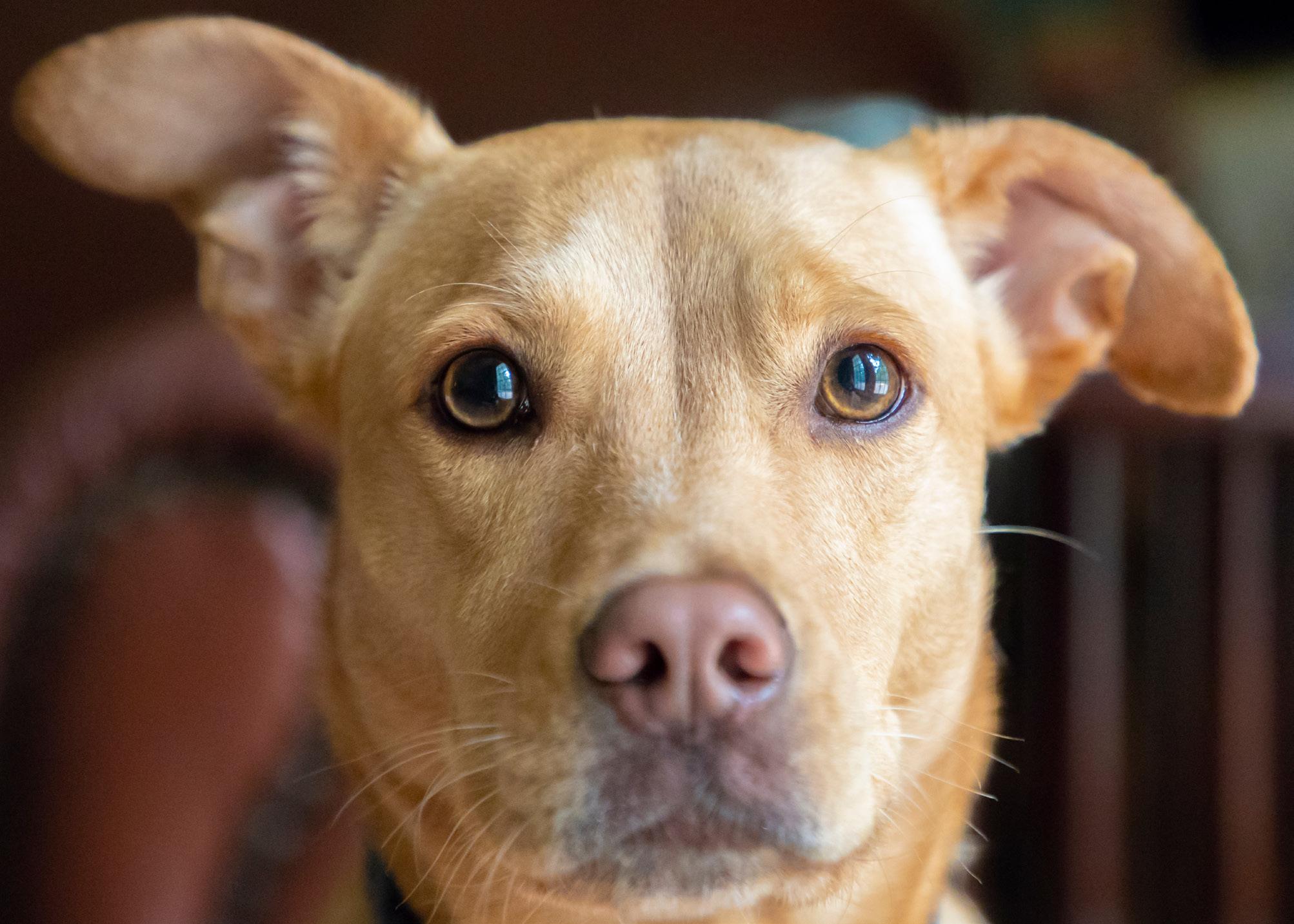
The first thing to remember is that it’s natural for dogs to be wary of loud noises, as in nature they’re an obvious signal of impending danger. If your dog is unable to identify the source of the noise, the fear response will simply compound. The question is, why do some dogs have such an extreme reaction and others seem completely unphased?
The answer comes down to a number of different variables, including sound sensitivity, temperament, separation anxiety, and past experiences. The loud noises and flashes of light in both storms and fireworks can put your dog immediately into fight or flight mode, and since they cannot possibly identify the source of the threat, their best chance is to run and hide. They can’t grasp that no matter where they go, they won’t be any further away from the noises than before.
Thunderstorms as opposed to other loud noises, add an extra level of stress to a dog’s mental processing system. If you have a dog who displays astrophobia (fear of storms) you may have noticed he seems to have an almost supernatural sense of when a storm is on its way. Dogs are much more sensitive to changes in air pressure than we are, and as their hearing is so much more acute, they can hear the low rumbling sounds of distant thunder much earlier than humans can. This is both a blessing and a curse for dogs and humans alike; on the one hand, it gives
DQ | 3B24 DOG BEHAVIOUR
us more time to prepare, and on the other, it means more hours of stress. Some vets postulate that as storms grow closer, our canine companions may also be experiencing small static shocks thanks to the build-up of electricity in the air, yet another element to make the whole process even more unpleasant.
IS NOISE PHOBIA CONTAGIOUS?
It has been observed that dogs who previously showed no aversion to thunder and firework noises, began to show definite signs of panic after being exposed to dogs already exhibiting the fear. In a medical sense, there is no way fear can be contagious, but dogs are social animals who survive thanks to advanced communication within the hierarchy. If one dog is scared, the others will assume there is a good reason for this, and may well start to become scared too. While some dogs seem unaffected by the fear of their counterparts, others will take on their fear as if it was their own.
CAN YOU PREVENT FEAR OF THUNDERSTORMS OR FIREWORKS?
Desensitising your dog can be effective in reducing fear, especially if you do so as a preventative measure when they are puppies. Pairing a loud, unpleasant sound with a positive experience can yield excellent results in the long term. When your puppy is eating, play some storm and firework noises very quietly until he shows no response. Slowly, make the noises louder over time until he is completely comfortable. If you do this regularly, you have a good chance of keeping the panic at bay. When an actual storm or fireworks display comes along, make sure you reinforce the relaxed behaviour by feeding your dog. Over time he will hopefully come to associate the positive experience (his food) with the potentially negative one (the scary noise).
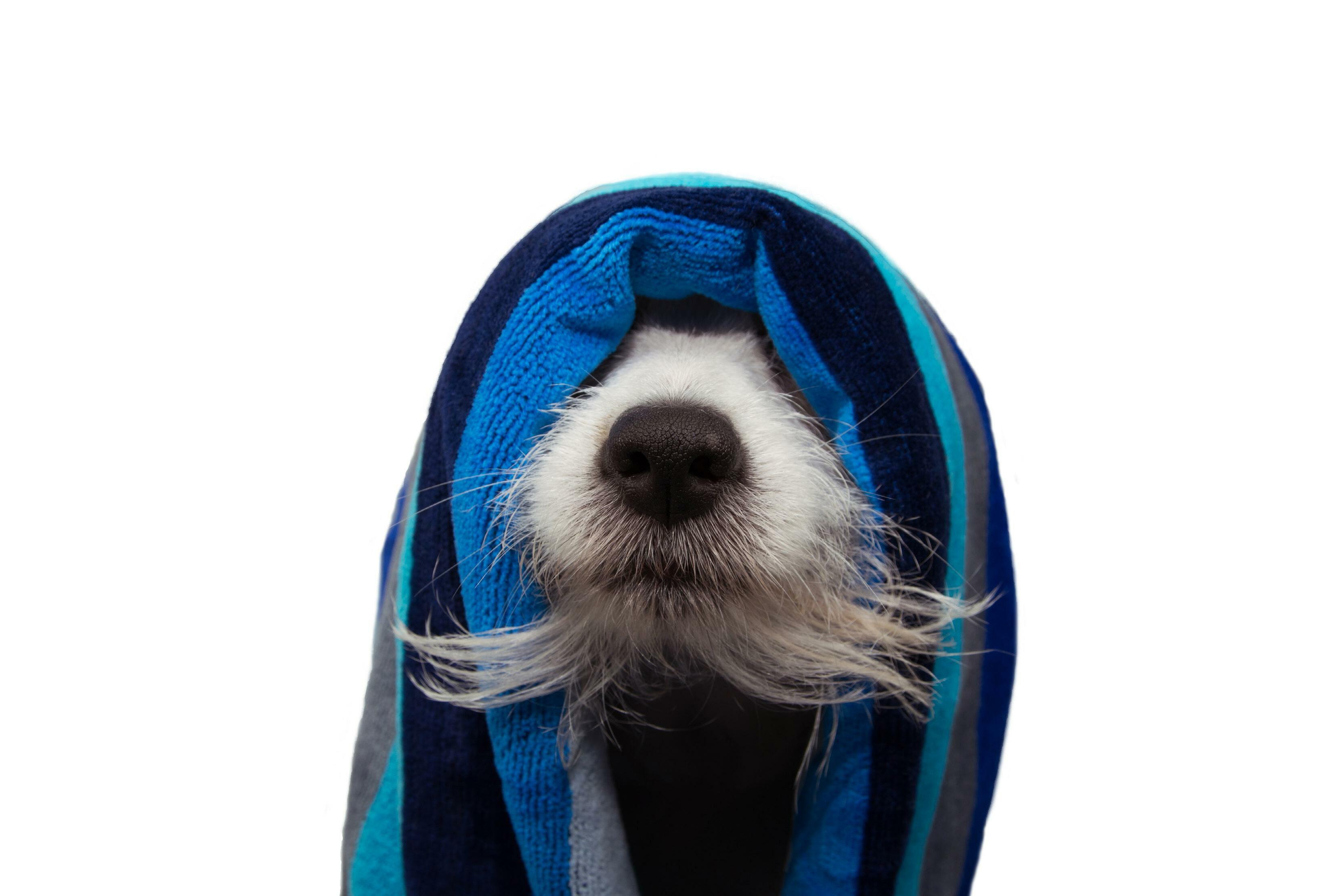
The desensitisation process is often successful, but it’s extremely difficult to simulate
all the elements in an actual storm, and your dog may still have a fear response to pressure changes and increased moisture in the air. Similarly, if your dog is already scared, systematic desensitisation takes a great deal longer to be effective. So, what do you do in the meantime?
WHEN THE STORM HITS
Fear of storms and fireworks isn’t just unpleasant for dogs and owners, it can also be extremely dangerous. Year after year we hear horror stories about terrified dogs being killed or injured trying to escape new year’s eve fireworks. As pet owners, we can’t always expect to be there when things go wrong, but there are things we can do to minimise the damage while you are in the process of desensitising.
DQ | 3B 25 DOG BEHAVIOUR
1. MAKE SURE YOUR DOG HAS A SAFE SPACE
When dogs are in a position they perceive to be threatening, they have three choices; fight, flight, or freeze. Giving your dog a safe space to flee when he feels threatened will calm his nerves. Generally, safe spaces will be kennels, under tables or blankets, or in cupboards; anywhere he feels sheltered. Encourage your dog to make use of his safe space in any stressful situation and he will eventually self-soothe this way. An absence of a safe space may cause him to run away in search of one, so make sure he can’t get outside during storms or fireworks. On the off chance, your dog does manage to escape, make sure he is microchipped, just in case.
2. DON’T OVERREACT
If your dog is already scared, he is going to be even more sensitive to your emotions. Keep calm and try and stay as “normal” as you can. Whatever you do, don’t make a big fuss of him when he’s in a panic state, as this will only
reinforce the behaviour and make him think he really does have something to be scared of. If he makes a mess, don’t shout at him or punish him in any way as this will only heighten his anxiety. Instead, act as though nothing out of the ordinary is happening at all.
3. BE PREPARED
You can’t make special arrangements every time there’s a storm, but if you know there are going to be fireworks in your area, especially if you’re not going to be at home, find a pet sitter to stay with him or arrange for him to go to a pet hotel for this period. Make sure he isn’t left alone. Again, he is a social animal and will be even more terrified if he doesn’t have company.
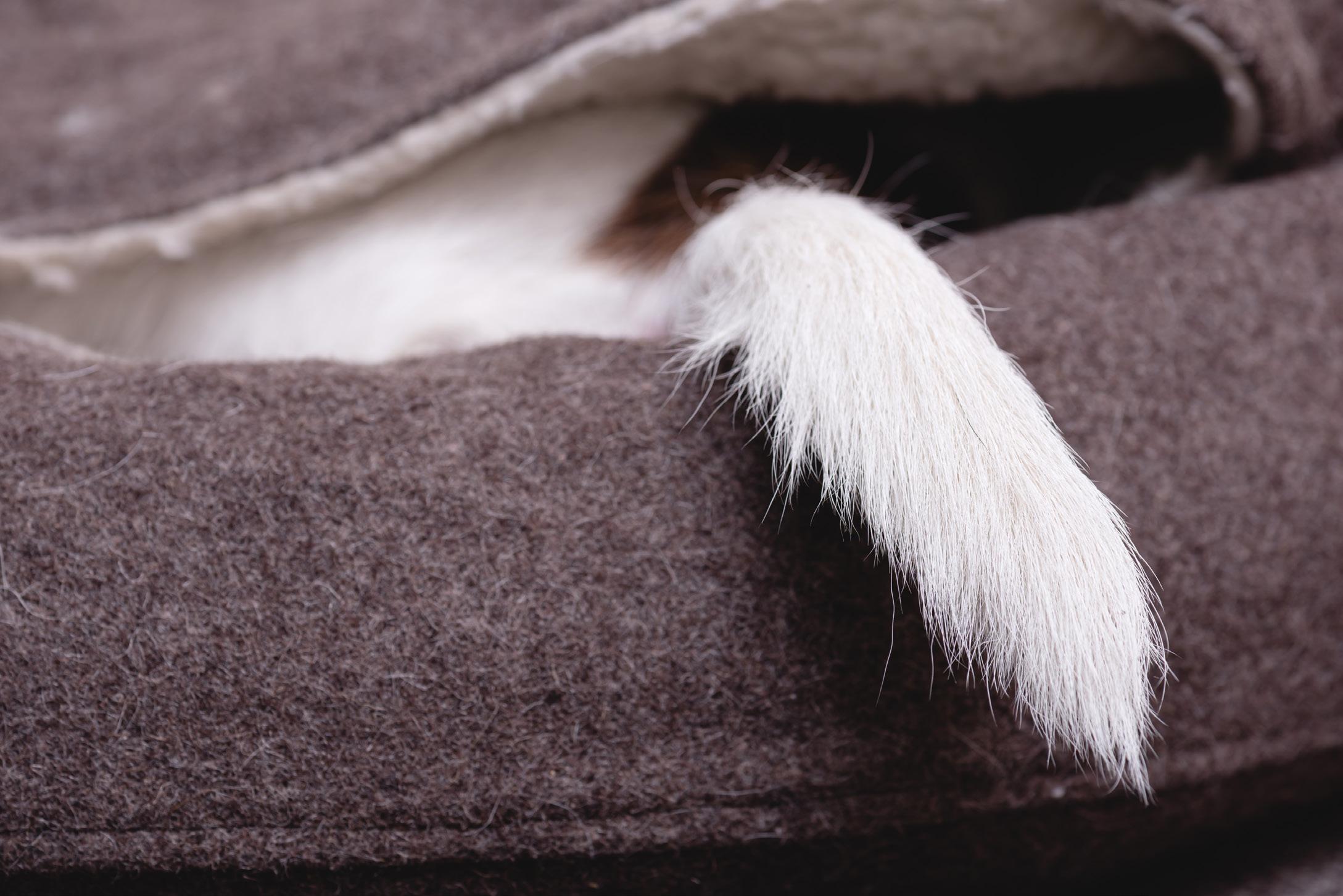
4. SHIFT THE FOCUS
Keep your dog distracted as much as you can during the noisy periods with music, white noise or the TV. Use whatever you have at your disposal to shift his focus
DQ | 3B26 DOG BEHAVIOUR
away from the source of his fear and towards something positive. If he’s up for it, use toys or food to make the whole experience more positive and contribute to the desensitization process at the same time.
5. THINK ABOUT COMPRESSION

Compression blankets like the Thundershirt have been known to soothe frightened canines. The principle is similar to that of swaddling a baby and applies a constant, gentle pressure to your dog. Studies show that this can be effective with some dogs, and is definitely worth a try if your dog is really struggling.
6. CONSULT THE EXPERTS
Every dog is different, and no one knows your dog better than you and your vet. If your dog’s phobia is unmanageable or is becoming worse, make an appointment with your vet and behaviourist and examine
the options likely to work best for your dog and your situation. Various calming supplements and medications are available and can also assist with the desensitisation process if used with the correct guidance. Take videos of your dog during the next storm and show them to your vet so they can fully understand the nature and severity of the fear response and, hopefully, find a workable and longlasting solution.
KEEP THINKING ABOUT DESENSITISATION
The ideal outcome for you and your dog is to overcome the fear altogether without having to plan your life around the issue and administer medication. The process of desensitising your dog can be a long and frustrating one, and it may well be worth getting a qualified behaviourist or trainer on board, but the results, if done correctly, are far superior. Don’t give up, stay calm, and you could find yourself with a much calmer dog.
DQ | 3B 27 DOG BEHAVIOUR
FOOT IN MOUTH

DQ | 3B28 DOG BEHAVIOUR
As with all dog behaviours, there are multiple reasons why dogs lick or chew their paws. These include habit, injuries, skin problems, environmental changes/challenges, parasitic infestations, food allergies, boredom or anxiety. Occasional paw licking is normal for dogs and is part of their self-grooming process, especially when they come inside after walking on dirty or sandy ground. However, if your dog frequently and intensely licks his paws or suddenly starts licking his paws, you can assume something is wrong.
INJURIES
The first step to take, especially if the licking begins very suddenly and is focused on one paw, is to examine the paw in question to make sure there is not an injury such as a cut, split, torn nail, growth, or perhaps a stone or thorn stuck between their pads. Your dog may have irritated his paw by steeping on something sharp, walking on hot sidewalks, being stung by a bee or getting a blister. During your inspection, make sure you look closely at the nails, between the toes and pads and also at the top of the feet. Some of these issues can be relieved by simple first aid and rest, while others might require a trip to the vet.
DERMATITIS
If the paw pads and feet look normal, the licking could be due to a skin condition (dermatitis) due to bacterial issues, allergies or food sensitivities. Your dog could develop dermatitis by being allergic to chemicals he’s walked in or certain types of grass or weeds. Cleaning off the paws as your dog comes in through the door could help to manage this condition.
FOOD ALLERGIES
Food allergies are known to cause itchy paws, and these types of allergies are difficult to identify specifically. Your vet may suggest a special diet or elimination of certain ingredients from your dog’s food to try and alleviate the problem.
PARASITES
Parasite infestations, such as those caused by fleas or mange, can cause the paws to be very itchy. Your vet can recommend treatments to eliminate the parasites, which should relieve the itching.
PAIN
Finally, a dog experiencing pain due to arthritis or other foot or leg conditions may lick his paws. Even if the pain is somewhere else in their body, some dogs will try to deal with it by licking a front paw continuously. In these cases the origin of the problem will require diagnosis and treatment by your vet.
BEHAVIOURAL ISSUES
If your vet has ruled out all of the above problems, then your dog may be suffering from boredom or a behavioural problem such as anxiety. Some dogs can also develop compulsive behaviours, which include paw licking. Again, the cause of these issues can be difficult to diagnose, but a certified animal behaviourist will be able to assist you.

SECONDARY INFECTIONS
It is important to recognise that licking behaviour can be indicative of a health problem or may become harmful to the dog in itself. You should work with your vet to determine the cause of the behaviour and find an appropriate solution. Don’t wait too long before consulting your vet, because the moisture resulting from constant paw licking can cause a secondary bacterial or yeast infection –causing even more itching, redness, swelling and licking.
TAKE-HOME MESSAGE
Depending on the underlying cause of the problem, the vet may relieve your dog’s itching by prescribing topical antiitch sprays, steroids to reduce inflammation, antibiotics for a bacterial infection, anti-parasite medications for parasite infestations or antifungals for yeast infections. The sooner you can address the problem and identify the cause, the better.
DQ | 3B 29 DOG BEHAVIOUR
MAKING THE BEST CHOICES FOR OUR BEST FRIENDS
While very early dogs had to be self-sufficient, eating, breeding, and exercising as and when they needed, today's pet dogs have fewer independent choices and rely on humans for their well-being. We now decide what they eat, when they eat, how they exercise and how they breed. All these choices have critical implications for their health and longevity.
The relationship we have with our dogs has a power imbalance; and with great power comes great responsibility. We have the responsibility to make the best choices we can for our best friends.
FEEDING FRESH FOR OUR HOUND'S HEALTH AND HAPPINESS
DQ | 3B30 ADVERTORIAL
Take Hildie, for example; she has been eating Happy Hounds since she was a pup. Look at that coat!

DQ | 3B 31 ADVERTORIAL
HUMAN IMPACT
Our selective breeding practices and daily choices for our dogs have impacted our dogs' DNA and their genetic expressions, i.e. which genes are activated/turned on or remain dormant. For example, we have a sizeable impact on whether dogs carrying a genetic predisposition to allergies and diseases will ever develop these ailments over the course of their lives.
Through the fields of epigenetics (how behaviour and environment affect gene expressions) and nutrigenomics (how food and nutrition affect gene expression), there is a growing body of evidence to indicate that the environment we create for our dogs and the food we feed them has the ability to activate dreaded diseases and allergies.
It is hard to ignore the correlation between the ubiquity of highly-processed dog diets and the rise of allergies and disease incidents in our pets. This begs the question, is there something in the food we have chosen for our dogs activating these ailments in our hounds?

THE RESEARCH
Studies have linked • the very high temperatures of extrusion (the process used to make kibble) to the development of carcinogenic chemicals; and • long-term processed food diets with elevated levels of inflammation markers associated with inflammatory issues such as allergies and cancer.
DQ | 3B32 ADVERTORIAL
Additionally, research has shown that
• Fresh food that is lightly cooked is more digestible for dogs (better bio-availability), meaning they are able to leverage the available nutrition more efficiently;
• Fresh food promotes gut microbiome diversity which can support improved gut and immune health;
• Fresh dog food can reduce blood lipids (fats); and

• Vegetables are associated with reduced cancer risk for dogs.
So, perhaps not surprisingly, we are learning that dogs, just like humans, thrive on a more diverse and minimallyprocessed diet. Choosing foods that are closely aligned with their ancestral diet but that leverage modern science and foods that exclude toxins and promote a heterogenous gut microbiome could avoid gene expression for allergies and, potentially, also dreaded diseases in our hounds.
Quite simply, fresh is better. Research has demonstrated that the minimum threshold of 20% fresh food in your dog's diet is the tipping point for health benefits.
As humans, we eat a wide variety of food on any given day and over the course of any given week. This means we can obtain our nutritional needs from a range of meals and don't need each meal to be nutritionally complete. Most of our hounds are more limited in their consumption habits,
eating only what we give them and, in most cases, eating the same thing almost every day. Therefore, it is advisable that every meal is nutritionally complete and balanced in and of itself.
LEGISLATION
There is legislation in place (Act36/1947 for those legal eagles out there) that requires all pet food to be certified by the Department of Agriculture, Land Reform and Rural Development (DALRRD) if it is going to be sold as a nutritionally complete meal. Companies like Happy Hounds have to submit our formulated food recipes and samples to the department. This is a detailed process and requires that the dog food recipes have been approved by pet nutritionists. If the recipes meet the necessary nutritional standards, the food will be certified 'Complete and Balanced' and given a certification number that starts with a 'V'.
So, the food we choose for our best friends needs to be certified Complete and Balanced at a minimum, but at Happy Hounds, we think this is one of those 'necessary but insufficient' criteria. We want to feed our best friends food that doesn't just meet their fundamental bio-nutrient requirements but exceeds them for improved holistic health and happiness.
Eye health
FEEDING HAPPY HOUNDS PROMOTES:
Cognitive function
Skin and coat health
Cell integrity
Muscle tissue maintenance
A healthy gut and digestive system
Dental health
Heart health
A healthy immune system
DQ | 3B 33 ADVERTORIAL
itchy skin, glossy coats and increased vitality in their dogs. With
It does not have to be fancy or complicated. At Happy Hounds, we want to make it easy for you to put fresh food back into your

DQ | 3B34
ADVERTORIAL
TICKLESS Pet keeps ticks and fleas away without the use of dangerous



chemicals. By fastening the easy-to-use, tiny device onto your cat or dog's collar, parasites can be kept away for up to 6 12 months after activation, leaving you and your pet free to enjoy nature.



Environmentally friendly, contains no chemicals or fragrances, safe for everyone
The device emits ultrasonic pulses that are imperceptible to humans and pets, but interfere with the ability of ticks and fleas to orient themselves, thus keeping them away.

all Tickless devices untilend October 2022Offer valid at www.mcmac.co.za onlyPromo code'TICKLESS-SPRING2022' 20% off
TEXT: MUNNIK MARAIS
THE SOUTHERN AFRICA ANIMAL CANCER ASSOCIATION
The South African Animal Cancer Association (SAACA) was established to cater for the needs of animals with cancer. Cancer is commonly seen as a more human illness, but it is prevalent in animals and needs more of our attention.
SAACA is the first organisation in Africa that focuses on cancer in animals. SAACA’s main objectives include the following:
• Working with Onderstepoort as a research institute to conduct research into animals with cancer. SAACA is very excited to have joined hands with the Faculty of Veterinary Science at the University of Pretoria to do this work.
• Educating the public on the topic of cancer in animals.
CANCER IN ANIMALS
Our pets suffer from many of the same cancers that impact people. Dogs and cats have been living with humans for centuries, sharing our homes and lifestyles—even scraps from our tables. Our pets also share many of the same cancers that develop in humans, possibly because of our shared environment.
According to the Veterinary Cancer Society, cancer is the leading cause of death in 47% of dogs (especially dogs over age ten) and 32% of cats. Dogs get
DQ | 3B36
CREATING AWARENESS ABOUT CANCER
WELFARE

DQ | 3B 37
For more information on SAACA or to donate to the organisation, visit its website www.saaca.org.za or email bark@saaca.org.za
cancer at about the same rate as humans, while cats have fewer cancers. There are over 100 types of cancers in dogs. Mast cell tumours are the most common. The most common cancers in cats are leukaemia and lymphoma. Most times, cancer is found in ageing animals, but some breeds have higher cancer rates than others.

There are many types of cancer, and each behaves differently. Some forms of cancer have the ability to spread to other sites in the body, which may be far from the original site. This occurs because these cancer cells can enter the blood or lymph vessels and be carried to other organs. When cancer has spread to other areas of the body, it is said to have metastasised.
“Early identification of cancer plays a vital role in the improvement of patient outcomes,” Dr Pazzi explained. “Owners should monitor their dogs and cats for any obvious lumps or bumps that may appear on the skin or in lymph nodes. We advise all pet owners to take their pets to a veterinarian or OVAH for evaluation if they are at all concerned.”
THEIR WORK
At the end of 2020, the founder and CEO of SAACA, Munnik Marais, approached the University of Pretoria’s (UP) Faculty of Veterinary Science with a proposal to join forces. Having spent many years fundraising for the Cancer Association of South Africa (CANSA), Marais wanted to create awareness of cancer in animals and encourage treatment and research.
Dr Paolo Pazzi, Section Head of Small Animal Medicine at UP, heads the research aspect of the oncology centre. “The goal of this collaboration is to increase the faculty’s capacity to treat cancer in animals,” he said. “This will result in an increase in research in this field. It will allow for earlier diagnosis of cancer and a wider spectrum of effective treatment options for animals.”
Dr Paul van Dam, Director of OVAH, said he was pleased with the collaboration with SAACA, which “will lead to benefits for the community and the co-creation of knowledge that can contribute to treating oncological conditions among animals”.
DQ | 3B38
WELFARE
DID YOU KNOW?
THE BEATLES SONG ‘A DAY IN THE LIFE’ HAS A FREQUENCY ONLY DOGS CAN HEAR. PAUL MCCARTNEY HAS SAID THAT HE ADDED A FREQUENCY ONLY DOGS CAN HEAR TO THE END OF THE BEATLES SONG ‘A DAY IN THE LIFE’, SO WATCH YOUR DOG WHEN YOU PLAY THE SONG!

DOG HEALTH DQ | 3B40
THE STAGES OF
PUPPY DEVELOPMENT
To ultimately have a well-adjusted and healthy dog, you must ensure that his needs are met during each development phase. Knowing how to manage a puppy through each developmental stage will help you create a happy and integrated family member.
THE FIVE STAGES OF PUPPY DEVELOPMENT
The puppy development process falls into five distinct stages. Puppies go through these stages at their own pace, so the timelines here are just a guideline.

DOG HEALTH DQ | 3B 41
1. NEONATAL PERIOD (0-2 WEEKS)
This is the first stage of puppy development, and it begins at birth. At this age, puppies only have the senses of taste and touch and rely totally on their mother to meet their every need.
2. TRANSITIONAL PERIOD (2-4 WEEKS)
During this time, the senses of hearing and smell develop. Puppy teeth start coming through, and their eyes will begin to open. This is also the age when your puppy's personality begins to develop. Puppies will interact with their litter mates, wag their tails, stand, walk a little and begin to bark.

3. SOCIALISATION PERIOD (3-12 WEEKS)
This is the most important stage of a puppy's development and critically is when the young pup goes home to live with his new family (between 7 and 12 weeks). During this period, changes occur rapidly.
Between 3-5 weeks, puppies start to become aware of their surroundings and have the ability to develop a relationship with people. This is the period when puppies get used to the day-to-day noises of a regular household. At this age, puppies are just learning to really interact with each other and will start to play. This means they are also learning their dog social skills and exploring how interactions work. Their curiosity develops, as do their biting skills! Nipping behaviours begin as they practice their biting behaviours with their mother and brothers and sisters.
At 7-9 weeks of age, their senses are all fully developed, and they are ready to go home to their new family. The challenge with this is it falls right in the middle of their socialisation period. Therefore, you must introduce your puppy to as many new dogs, people, objects and surroundings as possible. Of course, this must be done in a controlled manner and must never put your puppy in a dangerous situation where they could get injured, scared or catch a disease. During this phase of development,
DQ | 3B42 DOG HEALTH

DQ | 3B 43 DOG HEALTH



DQ | 3B44 DOG HEALTH
puppies develop much more consistent reactions to things. They are also likely to focus on different types of people and should be friendly to strangers. They are also very curious and will probably try and explore their environment more than before. For this reason, puppies should always be kept close to you or on a leash.
4. TESTING PERIOD (3-6 MONTHS)
This is when your puppy starts to test their boundaries within their world. They will begin to push the limits with their owners and other animals. At this age, many adult dogs will start to enforce manners in these youngsters. As you might expect, problematic behaviours can begin to arise in this period, so it is important that you start a training programme with your puppy if you haven't already. You want to find a positive training class and also practice at home on a daily basis.
At this age, your puppy will also go through a teething phase, and chewing is a common side effect. To avoid your puppy chewing everything in sight:
• Don't leave him unattended
• Make sure he has plenty of chew sticks and toys
• Use commercial sprays to dissuade your puppy from chewing your belongings.
Puppies are usually finished teething by 6 months when the upper canines come in.


TOP TIP
Soak a cloth in chicken stock and freeze it if your puppy is experiencing pain while teething. Once frozen, this can be given to your puppy as a chew toy and helps to relieve pain from sore gums.
DQ | 3B 45 DOG HEALTH
SIGNS OF PUBERTY IN DOGS
are the typical
Males:
Females:
5. ADOLESCENCE (6-18 MONTHS)
This is commonly the most challenging time during a puppy's development. Your adorable little puppy starts to become a teenager and will start producing hormones that may result in behaviour changes. NOTE: Dogs go through adolescence at different times, depending on their size; for small breeds, it can be as early as months old while larger dogs start at nine or ten months of age. Adolescence in larger breed dogs continues until there are two or three years old, with smaller dogs reaching maturity at about 18 months. Typically, the larger the dog, the slower the development.

Characteristic behaviours of the adolescent dog include:
• Inappropriate chewing (furniture etc.) and general destructiveness
LOTS of energy
Starting sexual behaviour if not spayed or neutered
Starting to claim the bed or couch areas and growling if you try to move him
Starting to pee or poo indoors
Displaying aggressive behaviour towards people or dogs
Resource guarding
Here
signs of puberty in dogs:
• Descent of testicles • Scent marking • Raising his leg to mark (pee) • Becomes less friendly • More interested in roaming and less interested in coming back to you • May start lifting his leg indoors • Can become aggressive towards other male dogs
• Usually starts with the first heat cycle • Exhibits erratic behaviour • Moody • Lethargic • Shows aggression You may see some or all of the above signs.
•
•
•
•
•
•
DQ | 3B46 DOG HEALTH
• Lack of focus and concentration
• Selective 'deafness,' i.e. doesn't come when called
Many of these behaviours will diminish as your puppy matures as long as you keep up training and socialisation through these periods.
One of the best ways to handle an adolescent dog is to give him plenty of daily exercise and continue positive training sessions. Consistency and routine are essential. If the dog displays any aggressive or other unmanageable behaviours, you should contact your vet, behaviourist or a certified trainer for assistance.
FEAR PERIODS
In addition to the five stages of development, puppies go through an average of four fear periods during their journey into adulthood:
• Between 8-10 weeks
• Between 4-6 months
• About 9 months
• Between 14-18 months
These fear periods, if mishandled, can create aggression problems so it is imperative to be aware of them. As your puppy enters a fear period, he will suddenly become frightened of something that he used to be okay with or used to ignore. He could react by shaking, backing away, hiding, running away, submissively urinating or hunching. Alternatively, he might growl, bark, raise his hackles or show his teeth.

Whatever signs he demonstrates, once you recognise one of these behaviours at the age range mentioned above, you should stop taking your puppy to new places and introducing them to new things for about a week. It is also best not to schedule any vet appointments during the fear period.
TAKE HOME MESSAGE
Familiarising yourself with these stages of development is critical in giving your puppy the best chance of adjusting optimally to family life. Puppies are a large commitment and these early years are particularly challenging, but if handled correctly, they can be enormously rewarding!
DQ | 3B 47 DOG HEALTH
HEATWAVE HEALTH
BEAT THE HEAT WITH THESE SCORCHING SAFETY TIPS
The recent heat waves have rocked the country. With temperatures as high as 37 degrees in some areas, the whole country has been on the alert, and water restrictions have been implemented in high-risk areas. No doubt you've seen the reminders to look after your pets in this heat, but what do you do to ensure they're alright?
HOW DO YOU KNOW IF YOUR DOG IS TOO HOT?
A simple rule of thumb with most animals is that if you're hot, your dog is hotter. Our canine friends aren't equipped to deal with the heat like we are, nor can they tell us when they're struggling. Understanding the signs of heat stroke
in dogs can be life-saving, so be sure to familiarise yourself with the following signs:
• Excessive panting. Dogs don't sweat from any part of their body except between the pads on their paws, so panting is their primary method of cooling down. Panting is normal in the heat, but keep an eye out for ragged or ceaseless panting.
• Reddened gums
Excessive drooling
Vomiting and diarrhoea
Mental dullness
Loss of movement
Collapse
DQ | 3B48 DOG HEALTH
•
•
•
•
•

DQ | 3B 49
If your dog has been in an environment where heat stroke is likely, it's always wise to be cautious if he displays any of these symptoms.
PREVENTING HEAT STROKE IN DOGS
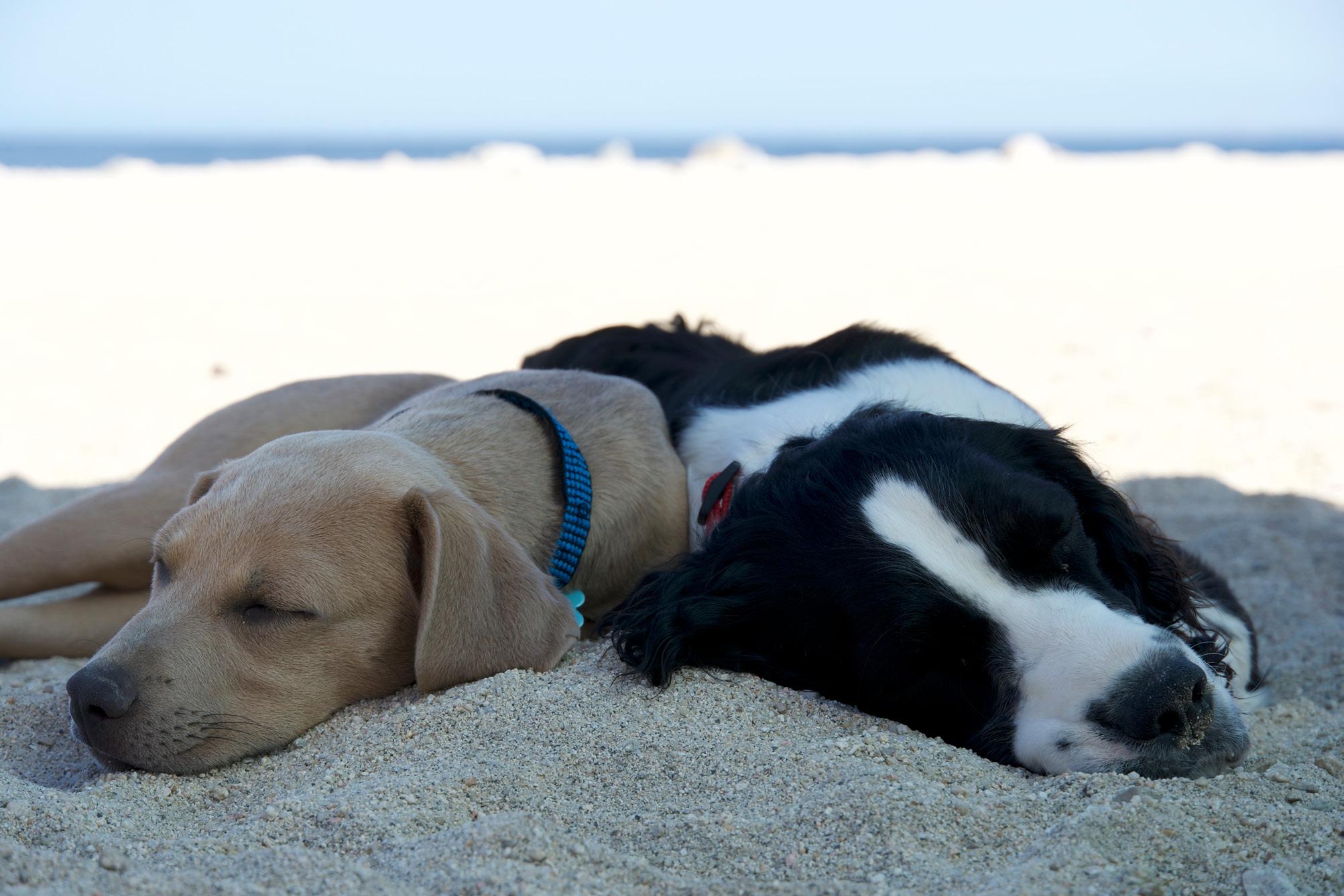
Prevention is better than cure, and there's a lot you can do to ensure your dog doesn't get heat stroke in the first place. Follow these simple DQ guidelines:
1. Cars are a hard no In temperatures as low as 22 degrees Celsius, the temperatures inside a closed space can quickly reach highs of up to 47 degrees, which can be fatal for animals trapped inside. Even short periods of time in the car can have disastrous results for your dog, and a quick 'pop-in to the shops' just isn't worth it.
2. Don't forget about the basics
When you're struggling with the heat, you want two things: 1) somewhere cool to sit and 2) plenty of fresh, cold water. Your dog is no different. Ensure his water is in the shade and that he has access to a cool room or shady area in the garden. A 'shell' paddling pool where he can get into the water if he wants to is a bonus, as long as he uses it. Introducing dogs to their paddling pools as puppies is extremely helpful in the long term.
3. Ice cubes are your friend
Adding ice cubes to your dog's water can make a big difference to his day. You can also freeze treats inside ice cubes to encourage him to lick and chew them.
DQ | 3B50 DOG HEALTH
4. Damp towels
Cool, damp towels to lie on can be such a relief for your dog. Just be sure to let him lie on them instead of covering him with them. Covering your dog in damp towels or blankets actually traps the heat close to his body, giving it no room to escape.
5. Regular grooming
For certain breeds of dogs, regular clipping and brushing can help alleviate the heat's effects. Discuss clipping your dog with a vet, as for some breeds, clipping actually makes things worse. Either way, give your dog a good brush once a week or more to remove excess hair.
6. Walking your dog in the heat
Some dogs need a walk no matter what the weather. If your dog is one of these guys, make sure you walk him as early in the morning or as late in the afternoon as possible. Avoid strenuous exercise in the heat for your dog, just as you would for yourself, and beware of sensitive pads on tarred roads. Imagine hot tar on your bare feet; not a nice thought. You can accidentally burn your dog's pads on his paws by taking him for a quick walk. Use the five-second test to establish whether a surface is suitable for a walk.
If it's too hot for your hands, it's too hot for your dog's paws. Stick to grass if you have to walk your dog in the hotter part of the day. Signs of burnt pads include:
• Limping and refusing to walk
• Licking or chewing his feet
• Pads are darker in colour
• Pieces are missing from the pads
• Blisters, redness, and sensitivity
WHAT TO DO IF YOUR DOG HAS HEAT STROKE
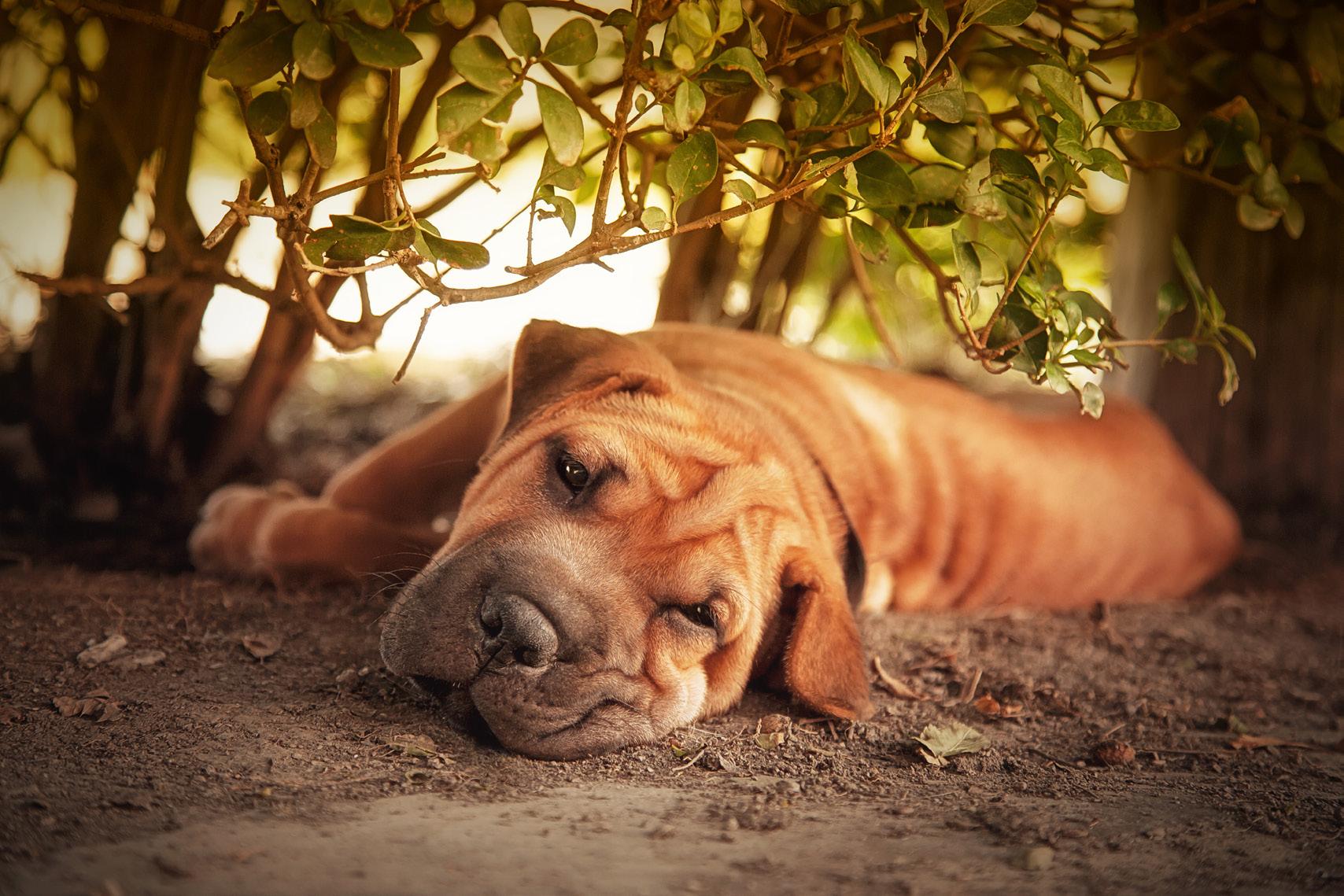
If the worst has happened, make sure to consult a vet immediately. Heat stroke can be fatal and shouldn't be taken lightly. Keep in mind:
• Don't suddenly immerse your dog in cold water to try and cool him down. Think about cooling him down slowly with wet towels and ice packs.
• Don't let your dog guzzle lots of water. Let him drink less but more frequently instead.
• Make sure he is in the shade and sponge him down.
FINAL THOUGHTS
Use these 'cool' pointers to have the safest summer, and enjoy the sunshine.
DQ | 3B 51 DOG HEALTH
CANINE ENRICHMENT
TEXT: SARAH WANLESS
Scatter feeding is one of the cheapest and easiest forms of canine enrichment out there. This method of slowfeeding enrichment involves scattering your dog's kibble (or a handful of treats if they are raw-fed) across an area, thereby allowing them to forage for dinner. It really is that simple!

SCATTER FEEDING 101
We recommend starting out by scattering the food in a small area of grass in your garden just to give your dog time to adjust to this new way of feeding. You can then build up the 'scatter area' from there. Scatter feeding encourages your dog to focus for more extended periods of time (an important skill), and as their attention span improves, you can increase the 'scatter area', spread the meal out in more challenging areas or even create a bit of an Easter Egg hunt both inside and outside the house.
BENEFITS OF SCATTER FEEDING
Scatter feeding is a great way to elongate your dog's meal time (great for those pups who wolf down their dinner) and is a low-arousal activity that engages your dog's brain and sense of smell. Believe it or not, a lot of dogs actually enjoy having to work for their meals.
Scatter feeding encourages your dog to relax, as the act of sniffing lowers the heart rate and stimulates the brain. It also has the added bonus of keeping your pup safe and busy while you send an email, take a bath or make dinner. Depending on the portion and the level of difficulty, a scatter feed can keep your dog busy for anywhere up to 20 minutes.
You can even take your scatter feeding on the move; this works especially well for fearful and reactive dogs but is a great enrichment opportunity for any dog. When you take your dog on a walk, be sure to take some treats and some
DQ | 3B52
PART 5
of their daily food allowance with you. Find a nice quiet spot and scatter; try to make it as challenging as possible by using longer grass or clover patches to encourage your dog to hunt around for their food. If your dog is encountering a stressful situation (like a dog nearby), move to an area below their reaction threshold (at a distance where they can disengage from the trigger, focus on you and happily accept treats) and do a small scatter feed to deescalate the situation.


SO, WHAT ARE YOU WAITING FOR?
Get out there and get scatter feeding!
DQ | 3B 53
BASIC EXERCISES FOR
DOG - Part Three
Text | Bianca Rootman
I hope everyone has been having lots of successful and fun attempts at some of the exercises discussed in the previous two articles.

love to hear from
see
videos
pictures
you trying the
home.
post pictures
Hydro

Animal
In Part Three, we’ll be discussing the walk. The walk, like the stand, is a ‘simple’ exercise that is often overlooked. It is definitely one of those daily actions that many of us take for granted, but if we think about the elderly or someone who is injured or compromised, and how difficult and exhausting they can find walking from point A to point B, we can see that the walk is not a simple gait. The walk is the only gait where your companion is forced to take weight on each leg individually. When the walk is slow and controlled, there are three paws on the ground at every phase of the walk, so cheating or avoiding weight bearing on a particular leg becomes very difficult.

YOUR
We would
you and
some
or
of
exercises at
If you
please tagDQ Magazine and
Health and
on social media. @animal_health_solutions @dogquarterlymag DQ | 3B54
Before challenging your companion, we first need to establish his current walking ability and fitness level. Do you take your companion for walks on a daily basis or only once a week? how far you walk, or how long you walk for? Is your companion completely exhausted afterawrds, are they visible tired but don’t seem sore or stiff, or do they behave as if they haven’t even gone on a walk? Taking note of these few factors will give you a baseline for challenging and progressing your walks. While looking at this baseline, you may also identify abnormalities.
The first common abnormality, which is often believed to be a cute quirk, is what we call the waddle. I’m sure you can all picture a dog walking in front of you waddling their bums side to side; there are many videos out there of this because, admittedly, it looks very cute. Yet, although it is cute, it is not right. Dogs who walk like that are not flexing through their hips and are actually using their backs to pull each hind limb forward by swinging half of their bodes from side to side. One can imagine the kind of strain that places on their backs. Another relatively obvious abnormality is crabbing. This is when your dog’s wheel alignment seems a bit off and they walk like a crab, not quite straight, but not quite skew. This too indicates a compensatory gait that can often be linked to an underlying condition or abnormality. The third, not so obvious abnormality, is pacing. This is when the dog moves like a camel, so the left fore limb and left hind limb will move together, and the right fore limb and right hind limb move together. This is often considered to be an energy saving gait that is displayed when the dog is fatigued, but it can also be an indication of an underlying condition or weakness, especially when the dog regularly paces. The other really obvious abnormalities one may pick up are limping, dragging of one or more paws, or tripping. These are all serious issues and should be checked out by a professional before you embark on any of theses exercises.
In terms of these exercises below, please just remember remember that not every exercise will be appropriate for your companion, and asking your companion to perform an exercise when they are weak or compromised could lead to injury, so please consult with your veterinarian or veterinary physiotherapist should you have any concerns, or notice that your companion is having any difficulty in performing the exercises.
Waddle Walk
DQ | 3B 55
The first simple way to change up your walk would be to add inclines, declines, and different surfaces. When your companion has to walk up or down a hill, they need to engage different muscles in their bodies in order to power up, or brace down the incline/decline. Allowing your companion to navigate appropriate terrain encourages your companion to be aware of his/her body by making them think about their next paw placement, and the different textures feel different under their paws, which stimulates the proprioceptive neural pathways.

The second way in which you could challenge your companion is by varying the pace at which he/she walks. Often times, your companion will struggle to walk slowly. When we slow our companions down, they can no longer use momentum to propel themselves forward, so they are forced to use each limb individually. This is when one can really pick up a problem, or when a problem becomes more visible. Asking your companion to walk a bit faster than normal is a nice way to challenge them too. You’ll need to find that sweet spot of asking for just enough, but not so much that they break into a trot.

DQ | 3B56
The third way to change up the walk is to add some obstacles that your companion will need to step over, and some obstacles to weave through. At home, one can use poles or broom sticks placed in a row on the floor, and ask you companion to walk down the line, stepping over each pole. Your dog may knock a few of the obstacles if they are not picking up their feet or legs properly. If out on a walk, you could find some tree roots of low branches and perform the same exercise. For the weave portion, one can simply take six objects, cones, or something that they are not able to step over, put them in a row and ask your companion to slowly weave through those. When out on a walk, one could weave through the lines on a road, or simply replicate the movement out in the field. These are nice exercises to work on body awareness and flexibility. If your companion struggles with, or is unable to do the exercises, please do not force the issue as they can both be hard exercises for a compromised dog.
FINAL THOUGHTS
These are some easy ways to challenge your companion whilst out on a walk, or even whilst walking around the garden. The walk is such an important and beneficial gait, and it is a relatively simple way to keep your companion, and yourself, mobile so please practice every chance you get!
Don’t forget to watch out for the last part of this series in the next edition of your favourite doggy magazine, DQ. In it, I’ll be discussing some other fun exercises to try with your companion.


ANIMAL HEALTH AND HYDRO RYNFIELD

154 President Brand Str, Rynfield, Benoni
Contact: 083 230 2188
Email: animalhealths@gmail.com
ANIMAL HEALTH AND HYDRO PRETORIA EAST
218 Mark St, Grootfontein County Estates, Pretoria East, Grootfontein Country Estates
Contact: 074 251 4410
Email: ahahpretoria@gmail.com
DQ | 3B 57
Why does my dog curl up in a ball to sleep? Surely he’d be more comfortable if he spread out?
Some dogs prefer to sleep curled up, and whilst we may anticipate that they would be more comfortable if they stretched out, it seems that this curled-up sleeping posture is inherited from their ancestors.

Dogs in the wild will dig a nest to sleep in and curl up in it – especially if it is chilly. This will help keep them warm and also keep their vital organs hidden away from predators. A dog will only stretch out if he feels safe and secure or is very hot!
Because of the preferred curled-up posture, a round bed might make your dog feel even more comfortable. Alternatively, he might just like a blanket to dig in and make his own nest!
DQ | 3B58
Do dogs dream?
ANSWERED BY SARAH WANLESS
Scientists have discovered that dogs do, in fact, dream. Scientific research has demonstrated comparable brain wave patterns in dogs and humans, validating the longheld assumption of owners that dogs dream. Like
us, dogs go through several sleep cycles, including Rapid Eye Movement (REM) sleep. REM sleep is the period during which we experience our most vivid dreams. For most dogs, dreaming should occur about 20 minutes after they begin to doze. You’ll notice shallow, irregular breathing followed by muscle twitching and eye movements behind closed eyelids.

DQ | 3B 59 Q&A
Why are dogs' noses wet?
 ANSWERED BY SARAH WANLESS
ANSWERED BY SARAH WANLESS
As dogs explore their world predominantly through their noses, their noses need to function optimally. While scientists aren't entirely sure why your dog's nose is wet, it is believed that dogs' noses secrete mucus to keep the nose and nasal canals moist. This thin layer of mucus lines the nostrils and enhances the ability of the nose to absorb
the scent chemicals, thereby improving your dog's ability to smell.
While a wet nose is the norm, a dry nose isn't always a cause for concern. Temperature and moisture are not necessarily good indicators of a dog's health status; some healthy dogs naturally have drier noses than others. Having said this, if you notice that your dog's nose is suddenly dry despite usually being wet, you should monitor them closely for other signs of illness and contact your vet if you are at all concerned.
DQ | 3B60 Q&A

Products we love
Shopping fun
Aromadog range
patented technology combined with natural aromatherapy, our toys are designed to aid in keeping your pet calm and happy throughout the day. Developed with Professional Aromatherapists, we have created a revolutionary new concept in squeaky toys. Made with 100% therapeutic grade blends, every play and squeak releases a calming blend of essential oils into the air - helping your dog associate their Aromadog toy with feeling relaxed and happy. With a soothing effect on the natural canine instinct to play and sniff, Aromadog can calm your dog in a number of

conditions
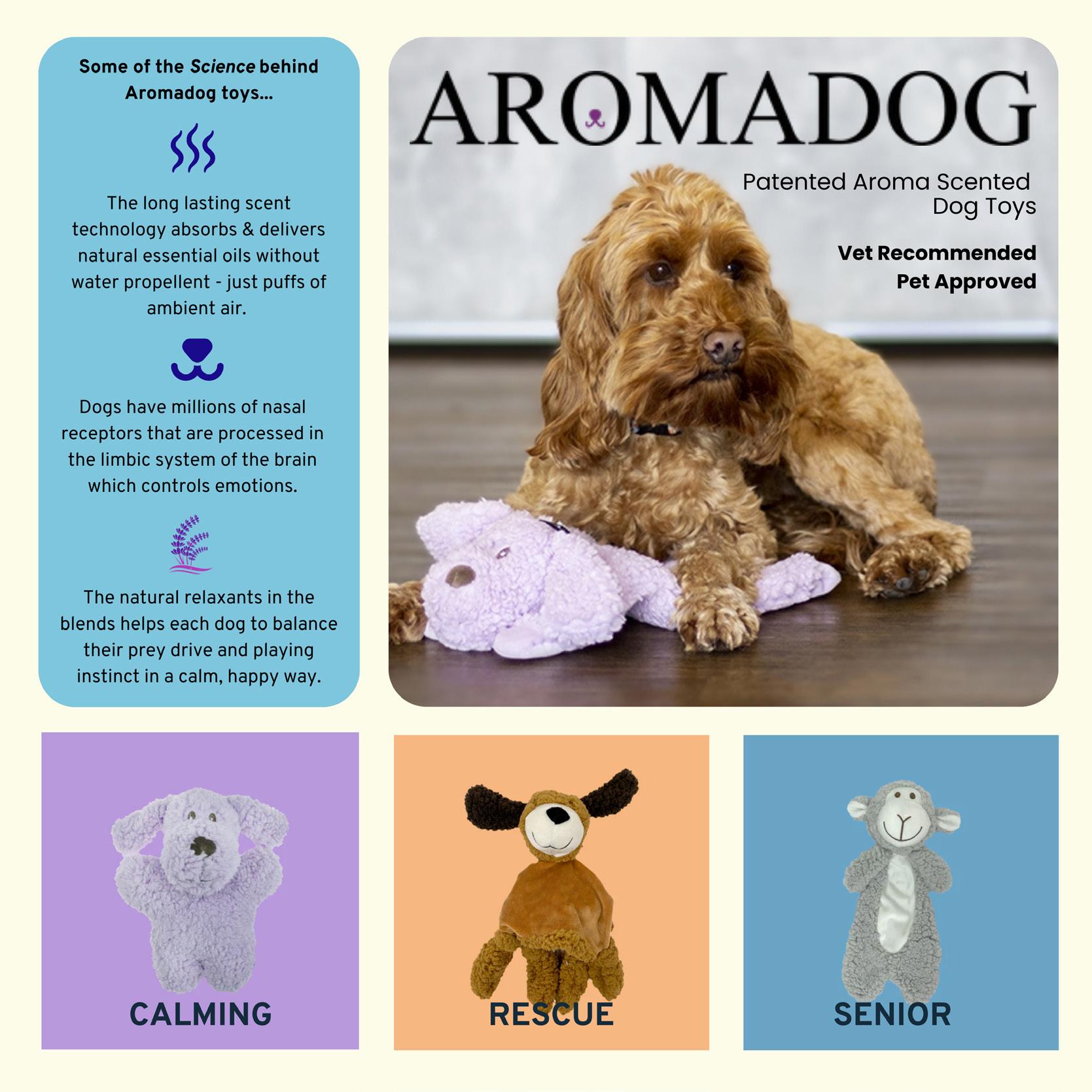
DQ | 3B62
Using
situations or
such as: • Hyperactivity • Separation anxiety • Night pacing • Thunderstorms • Vet visits • Travel anxiety • Boredom • Fireworks Visit www.mcmac.co.za for more information.
DID YOU KNOW?
Bloodhounds can follow tracks that are over 300 hours old and can stay on a trail for over 210km!
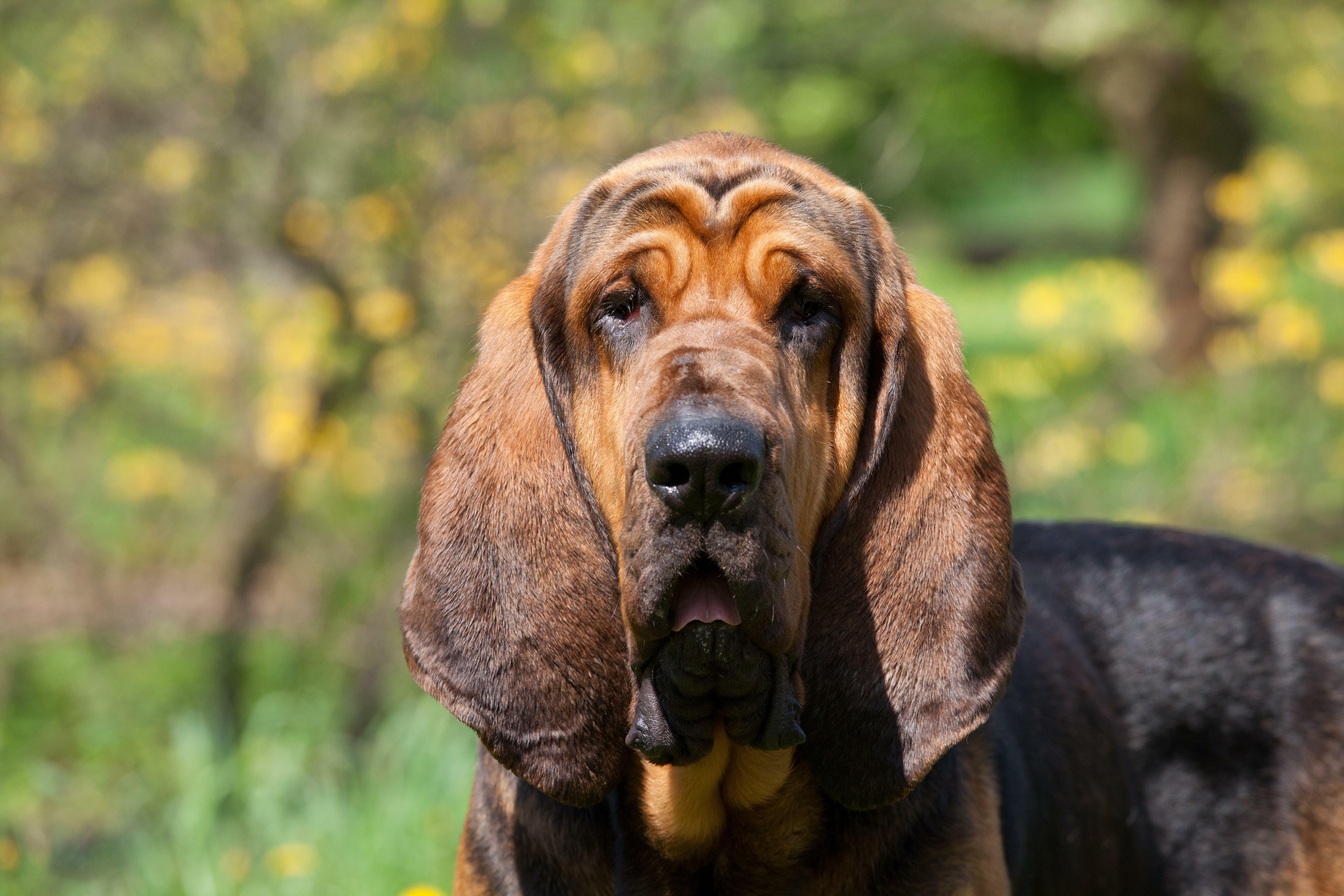
DQ | 3B 63
DQ | 3B64 NEXT ISSUE 15 NOVEMBER 2022 www.dqmagazine.co.za
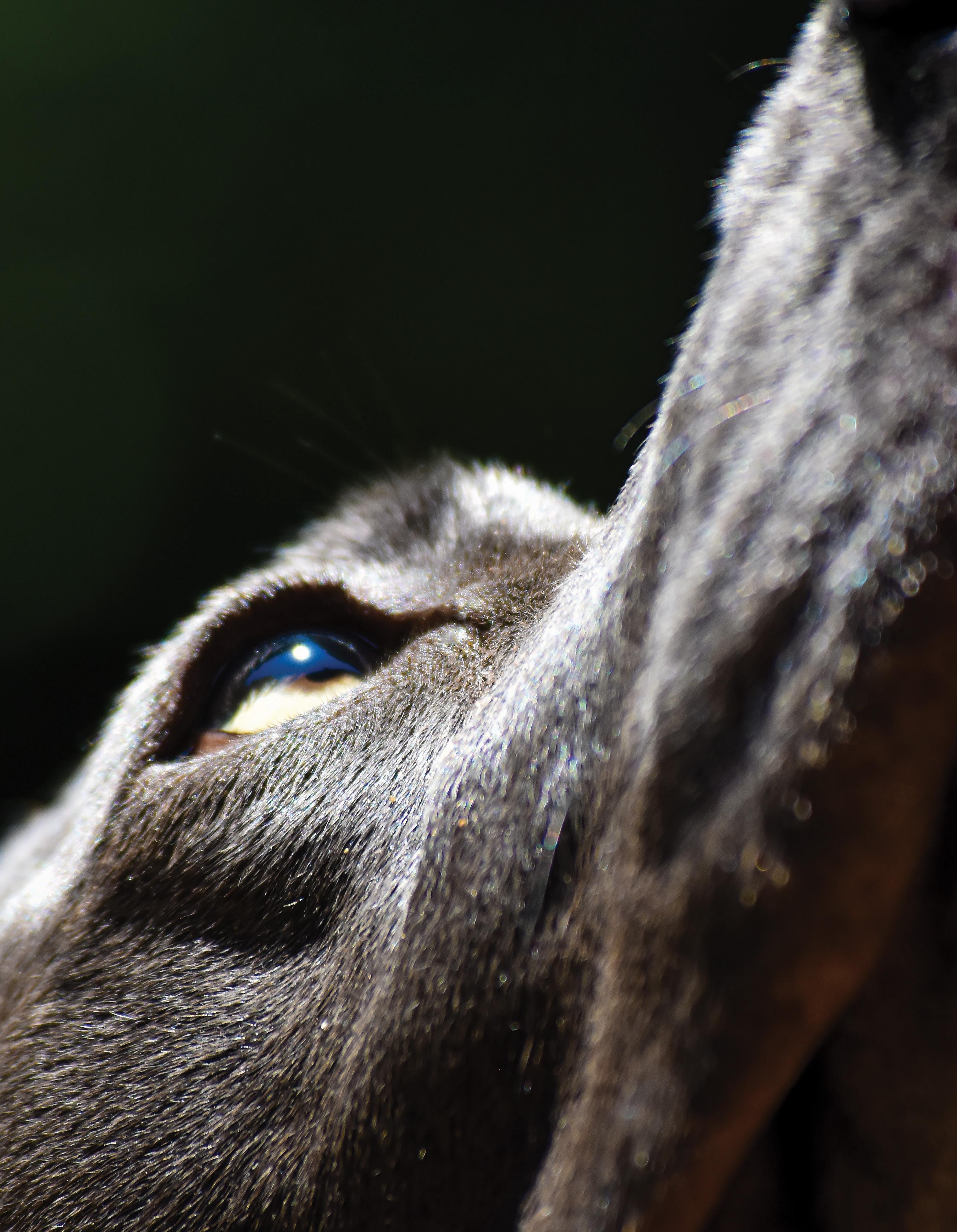



































































 ANSWERED BY SARAH WANLESS
ANSWERED BY SARAH WANLESS





